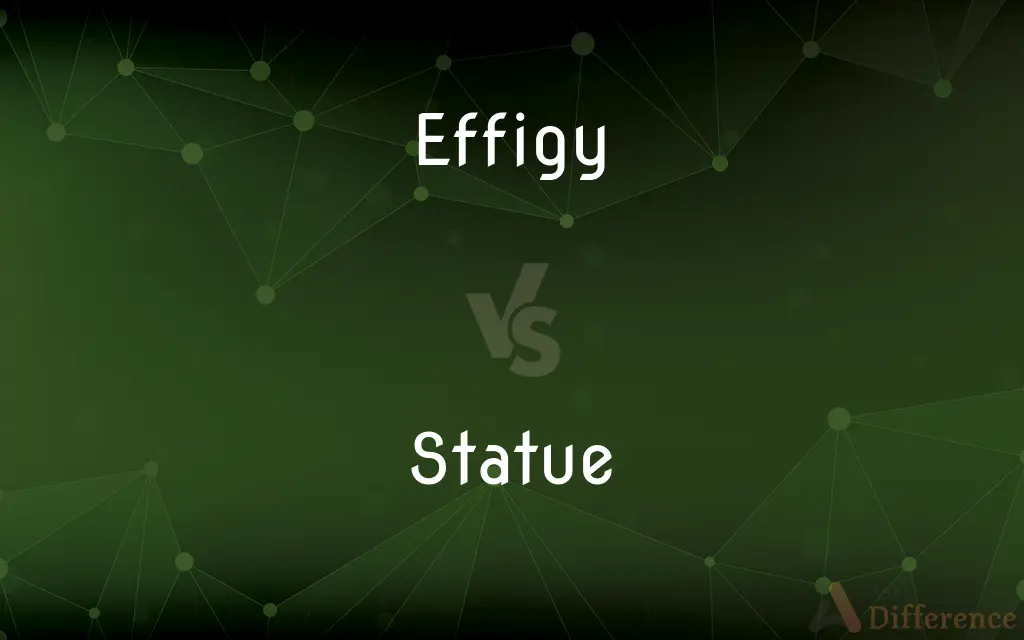Effigy vs. Statue — What's the Difference?
Edited by Tayyaba Rehman — By Fiza Rafique — Updated on April 5, 2024
An effigy is a representation often used for ridicule or protest, typically burned, whereas a statue is a sculpture honoring or memorializing a person or event.

Difference Between Effigy and Statue
Table of Contents
ADVERTISEMENT
Key Differences
Effigies are often created with the intent of destruction, symbolizing disdain or protest against a figure or idea, often seen in political demonstrations. On the other hand, statues are crafted as enduring tributes, installed in public places to commemorate cultural or historical significance.
While effigies can be made from perishable materials like straw or paper, intended for temporary display and eventual burning, statues are usually made from durable materials like bronze, stone, or metal, designed to last for generations and withstand environmental elements.
Effigies often carry a negative connotation, embodying the rejection or condemnation of an individual or symbol. Statues, however, are generally positive, celebrating achievements, virtues, or contributions to society.
The creation of an effigy is usually a collective, sometimes anonymous, act, reflecting a community's dissent or mockery. Conversely, statues are created by artists or sculptors, often commissioned by public or private entities, reflecting skilled craftsmanship and artistic vision.
Effigies serve a specific purpose at a point in time, linked to events or sentiments of the moment. In contrast, statues serve as timeless markers, preserving memory and inspiration for future generations.
ADVERTISEMENT
Comparison Chart
Purpose
Protest or ridicule
Honor or memorialize
Material
Perishable (e.g., straw, paper)
Durable (e.g., bronze, stone)
Connotation
Negative
Positive
Creation Process
Collective or anonymous
Commissioned by artists
Longevity
Temporary
Permanent
Symbolism
Dissent or mockery
Achievement, virtue, contribution
Public Perception
Often controversial
Generally revered
Compare with Definitions
Effigy
A crude representation of someone disliked, used for purposes of ridicule.
The protestors paraded an effigy of the leader through the streets.
Statue
Made from durable materials like bronze or marble.
The marble statue stood tall in the central square.
Effigy
A figure made to be destroyed, especially by burning.
They burned an effigy at the demonstration.
Statue
Often placed in public spaces for collective memory.
A new statue in the park commemorates the local veterans.
Effigy
Often symbolic in protests or political dissent.
An effigy symbolizing greed was displayed at the rally.
Statue
Represents historical, cultural, or moral values.
The statue symbolized the community's commitment to peace.
Effigy
Made from easily destructible materials.
The effigy, made of straw and cloth, was quickly consumed by fire.
Statue
A sculpture representing a person or idea, intended as a permanent tribute.
The city unveiled a statue to honor the national hero.
Effigy
Represents a temporary embodiment of public sentiment.
The effigy captured the crowd's current anger.
Statue
Reflects the artistry and vision of its creator.
The sculptor's latest statue was a testament to their skill.
Effigy
An effigy is an often life-size sculptural representation of a specific person, or a prototypical figure. Lately, the term is mostly used for the make-shift dummies used for symbolic punishment in political protests and for the figures burned in certain traditions around New Year, Carnival and Easter.
Statue
A statue is a free-standing sculpture in which the realistic, full-length figures of persons or animals or non-representational forms are carved or cast in a durable material such as wood, metal or stone. Typical statues are life-sized or close to life-size; a sculpture that represents persons or animals in full figure but that is small enough to lift and carry is a statuette or figurine, whilst one more than twice life-size is a colossal statue.Statues have been produced in many cultures from prehistory to the present; the oldest-known statue dating to about 30,000 years ago.
Effigy
A sculpture or model of a person
A tomb effigy of Eleanor of Aquitaine
Statue
A carved or cast figure of a person or animal, especially one that is life-size or larger.
Effigy
A crude figure or dummy representing a hated person or group.
Statue
A three-dimensional form or likeness sculpted, modeled, carved, or cast in material such as stone, clay, wood, or bronze.
Effigy
A likeness or image, especially of a person.
Statue
A three-dimensional work of art, usually representing a person or animal, usually created by sculpting, carving, molding, or casting.
Effigy
A dummy or other crude representation of a person, group or object that is hated.
Statue
(dated) A portrait.
Effigy
A likeness of a person.
Statue
(transitive) To form a statue of; to make into a statue.
Effigy
The image, likeness, or representation of a person, whether a full figure, or a part; an imitative figure; - commonly applied to sculptured likenesses, as those on monuments, or to those of the heads of princes on coins and medals, sometimes applied to portraits.
Statue
The likeness of a living being sculptured or modeled in some solid substance, as marble, bronze, or wax; an image; as, a statue of Hercules, or of a lion.
I will raise her statue in pure gold.
Effigy
A representation of a person (especially in the form of sculpture);
The coin bears an effigy of Lincoln
The emperor's tomb had his image carved in stone
Statue
A portrait.
Statue
To place, as a statue; to form a statue of; to make into a statue.
Statue
A sculpture representing a human or animal
Common Curiosities
Where are statues usually placed?
Statues are usually placed in public areas like parks, squares, or outside buildings to be seen and appreciated by the public.
Why are effigies burned?
Effigies are burned as a symbolic act of protest or disdain towards the individual or idea they represent.
What is a statue?
A statue is a three-dimensional sculpture, typically made of durable materials, that honors or memorializes a person, event, or concept.
How are statues made?
Statues are made by sculptors who use materials like bronze, stone, or marble, employing techniques such as carving, casting, and welding.
What is an effigy?
An effigy is a representation of a person, often made to be destroyed as a form of protest or ridicule.
Can effigies have positive meanings?
While traditionally associated with negative sentiments, effigies can also be part of cultural or religious rituals with positive connotations.
What materials are used to make effigies?
Effigies are often made from perishable materials like straw, cloth, or paper, intended for temporary use and easy destruction.
Are all statues made to honor people?
While many statues honor individuals, others commemorate events, concepts, or serve purely artistic purposes.
What's the difference in intent between an effigy and a statue?
Effigies are intended for protest or ridicule, while statues are made to honor, memorialize, or inspire.
What happens to effigies after they are used?
Effigies are usually destroyed, often by burning, as part of their intended use.
Can statues be controversial?
Yes, statues can be subjects of controversy, especially if they represent divisive historical figures or events.
Can anyone create a statue or an effigy?
While anyone can theoretically create an effigy, creating a statue typically requires more skill and resources.
How long do statues last?
Statues can last for centuries or even millennia, depending on the materials used and maintenance provided.
Do effigies have to represent real people?
Effigies can represent real people, concepts, or entities, depending on the context of their use.
How do effigies and statues affect public spaces?
Effigies can provoke thought or controversy in public spaces, whereas statues often contribute to the cultural or historical significance of a location.
Share Your Discovery

Previous Comparison
Resoled vs. Resold
Next Comparison
Vishnu vs. KrishnaAuthor Spotlight
Written by
Fiza RafiqueFiza Rafique is a skilled content writer at AskDifference.com, where she meticulously refines and enhances written pieces. Drawing from her vast editorial expertise, Fiza ensures clarity, accuracy, and precision in every article. Passionate about language, she continually seeks to elevate the quality of content for readers worldwide.
Edited by
Tayyaba RehmanTayyaba Rehman is a distinguished writer, currently serving as a primary contributor to askdifference.com. As a researcher in semantics and etymology, Tayyaba's passion for the complexity of languages and their distinctions has found a perfect home on the platform. Tayyaba delves into the intricacies of language, distinguishing between commonly confused words and phrases, thereby providing clarity for readers worldwide.














































